Downtown Park Proposal Moves to Council
Ann Arbor park advisory commission meeting (Oct. 15, 2013): Commissioners who’ve been evaluating possibilities for downtown parks and open space delivered their recommendations at this month’s meeting, wrapping up an effort that traces back over a year.
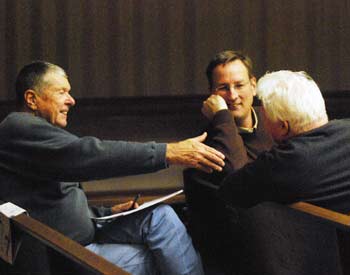
From left: Bill Higgins, Harry Sheehan and Mike Anglin, a Ward 5 Ann Arbor city councilmember. Sheehan is environmental manager with the Washtenaw County office of the water resources commissioner, and gave an update on the Upper Malletts Creek stormwater management project. Higgins lives in the neighborhood that’s the focus of the project. (Photos by the writer.)
The report of the downtown parks subcommittee includes several broad recommendations based on feedback gathered over the past few months, with an emphasis on “placemaking” principles that include active use, visibility and safety. The most specific recommendation calls for developing a park or open space on top of the city-owned Library Lot underground parking structure, adjacent to the downtown library.
A park at that location should exceed 5,000 square feet, according to the report, and connect to Library Lane, a small mid-block cut-through that runs north of the library between Fifth and Division. That connection offers flexibility, because the lane can be closed off for events to temporarily increase the size of a park or open space at that location.
Commissioners discussed and made some minor amendments to the subcommittee’s recommendations, which they then unanimously voted to approve. Most of the discussion focused on the Library Lot site. The recommendations will be forwarded to the city council for consideration.
Also on Oct. 15, Harry Sheehan briefed PAC about how a stormwater management project for Upper Malletts Creek might impact three city parks: Eisenhower, Churchill Downs and Lawton. The project, overseen by the Washtenaw County office of the water resources commissioner, is still in the planning phase. It’s intended to help control flooding in a neighborhood that’s roughly bounded by I-94, Scio Church Road and Ann Arbor-Saline Road, on the city’s southwest side.
Park planner Amy Kuras updated commissioners on capital projects throughout the parks system, highlighting projects that were completed this summer as well as work that’s ongoing, like construction of the Ann Arbor skatepark.
Missy Stults, PAC’s representative on the city’s environmental commission, reported that the commission has developed a work plan with strategies that are mostly tied to the city’s sustainability framework and climate action plan. For example, the plan includes work to promote re-useable water bottles and to discourage the use of plastic water bottles. One idea is to develop an app that would show people where to get public water, including water fountains in city parks. Tying in with that work plan item, Colin Smith – the city’s parks and recreation manager – reported said the city is looking to replace several water fountains at parks and recreation facilities with fountains that indicate how many plastic bottles have been saved by people using the water fountains. He noted that similar fountains are used at the University of Michigan.
Oct. 15 was the final meeting for Julie Grand, who is term limited after serving six years on PAC. Grand, who served on the downtown parks subcommittee, thanked commissioners for passing the recommendations, saying “it’s a great way to go out.”
Downtown Parks Recommendation
A group that’s been meeting since early 2013 – to explore the possibilities for a new downtown park – delivered a set of recommendations at the Oct. 15 meeting. [.pdf of 21-page full subcommittee report]
Ingrid Ault, who chaired the downtown parks subcommittee, began the presentation by reviewing the genesis of this effort. This subcommittee – Ault, Julie Grand, Alan Jackson and Karen Levin – has been meeting regularly since early February. Their work relates in part to a request that mayor John Hieftje made last summer. It’s also meant to supplement the Ann Arbor Downtown Development Authority’s Connecting William Street project. Ault noted that the city’s parks and recreation open space (PROS) plan also identified a desire for downtown open space.
The subcommittee’s work was guided by this mission statement:
To determine whether and what additional parks are wanted and/or needed in downtown Ann Arbor, focusing on city-owned parcels in the DDA district while maintaining awareness of additional nearby properties, for example: Liberty Plaza, 721 N. Main and 415 W. Washington. The “deliverable” will be a set of recommendations for the City Council.
In addition to conducting research, inventorying existing downtown and near-downtown parks, and holding focus groups and public forums, some subcommittee members also attended a “placemaking” seminar in Lansing, held by the Michigan Parks & Recreation Association.
Ault said that placemaking principles helped guide the recommendations. Examples she cited include places that have surrounding “active uses” with high pedestrian traffic and good visibility, places that promote activities that the community desires, and that are easily accessible and flexible. Spaces also need to feel safe and comfortable, she said.
Julie Grand continued the presentation, reviewing results of a survey conducted by the subcommittee that yielded more than 1,600 responses. [.pdf of 110-page downtown park survey results] The subcommittee recommendations were based in part on that feedback. Grand noted that most respondents lived in the 48103 zip code area, which might reflect proximity to the downtown or that residents there just like to take surveys, she quipped.
The eight recommendations are wide-ranging, but include a site-specific recommendation to develop a new park/open space area on the top of the Library Lot underground parking structure. Now a surface parking lot, the site is owned by the city and is situated just north of the Ann Arbor District Library’s downtown building. The recommendation calls for only a portion of the site to be used for a new park/open space, and stresses that AADL should be involved in the planning process.
The subcommittee’s eight recommendations, as amended during the meeting, are as follows [added text in italics, deletions in strike-through]:
1. The development of any new downtown park or open space should prioritize community preferences. The most commonly expressed community-based priorities include: a central location; sufficient size for passive recreation/community gatherings; shade; and natural features.
2. New downtown parks and open space should adhere to placemaking principles. Necessary criteria for a successful downtown open space include: high traffic/visibility; flexible programmable space; active use on at least three sides; the ability to provide activities desired by the community; and funding for maintenance and security.
3. Any new downtown park should enliven the downtown, complement existing parks and development, and serve the community desire for a central gathering space.
4. Any additional downtown park space should not come at the expense of the quality or maintenance of Ann Arbor’s existing parks. Downtown parks are expected to be more costly to develop and maintain. Further, existing downtown parks are not currently utilized to their potential. Given the limits of current parks funding, the development of new parks should not be approved without an identified funding source for capital development, ongoing maintenance, and programming.
5. Significant capital/structural improvements to Liberty Plaza should only be made in concert with the adjacent property owner. Short-term efforts should continue to focus on smaller-scale incremental changes (removal of shrubbery) and programming opportunities (fee waiver). Future improvements should also work to create a permanent and highly visible connection between the Library Lot and Liberty Plaza.
6. The downtown could benefit from the addition of small “pocket” parks and flexible spaces. The City should work with potential developers of city-owned properties to identify opportunities, create, and maintain privately funded, but publicly accessible open spaces. (e.g., the Y and Kline lots). As a part of this effort, staff should develop recommendations for how development contributions can better serve to provide and improve downtown passive recreational opportunities, including proposals such as flex space (parklets), streetscape improvements, and public art.
7. The public process for downtown parks and open space does not end with these recommendations. Any additional park/open space would require robust public input regarding the design, features, and proposed activities.
8. Based on the aforementioned criteria, the Downtown Parks Subcommittee recommends that a park/open space be developed on the Library Lot that takes advantage of the flexibility offered through temporary closures of Library Lane. The size of this space should exceed the proposed allocated open space in the Connecting William Street study (5,000 square feet). However, the subcommittee is strongly in favor of a mixed-use vision for the Library Lot that utilizes the city’s investment in development-ready foundation and infrastructure. Adjacent Development of the site and adjacent parcels, including the accompanying increases in activity, is essential for the future success of this site additional downtown open space. In order to adequately address issues of safety and security, the Ann Arbor District Library must also be strongly represented in the planning process.
The Library Green Conservancy has been advocating for a park atop the Library Lot, but conservancy members envision a much larger footprint than the one proposed by the Connecting William Street report. During deliberations on Oct. 15, it emerged that the subcommittee hoped for more than the minimum size of 5,000 square feet that was mentioned for a park or open space on that site in the Connecting William Street report.
The subcommittee’s report also described the input received from several groups that gave feedback about possible downtown parks, including from Library Green Conservancy members and officials of the Ann Arbor District Library. The AADL’s downtown building is adjacent to the Library Lot. From the report:
The AADL representatives shared issues they have experienced with security, drugs, and loitering both inside and outside of the downtown library branch. They shared that they employ four full time security guards to deal with these issues, and have concerns about adding a large public open space outside of their building. Although in concept a park sounds like it would complement the library and its programs, without continuous security, high level of maintenance and continuous programming, there was concern that the space would create another venue for the behavioral issues they experience on a daily basis at the library and at Liberty Plaza.
For additional background, see Chronicle coverage: “Parks Group To Weigh In On Downtown Need,” “Committee Starts Downtown Parks Research,” “Survey Drafted for Downtown Parks,” as well as coverage included in the PAC meeting reports for March 19, 2013 and May 21, 2013.
Downtown Park Recommendation: Commission Discussion – Library Lot
Christopher Taylor, an ex officio, non-voting member of PAC who serves on the city council, kicked off the discussion by asking about the Library Lot recommendation. He asked whether the proposal includes Fifth Avenue access to the parcel. Julie Grand replied that she intentionally made that recommendation vague. In writing up the recommendations, she didn’t feel comfortable making it more specific, because she felt there should be a conversation about it at PAC. She noted that in the Connecting William Street plan, there’s the idea of potentially opening up any open space on Library Lot more on the Fifth Avenue side.
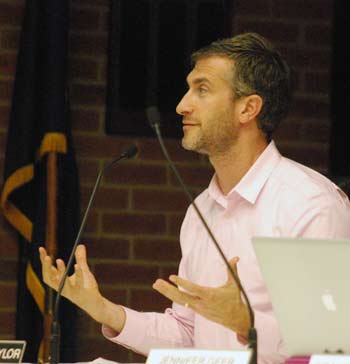
Christopher Taylor, an Ann Arbor city councilmember and ex officio member of the park advisory commission.
Taylor pointed out that there’s always been open space anticipated in the plan for the top of the Library Lot, and that the heavy foundation of the underground parking structure was created with the idea that part of the surface would be open space, as well as development that would have access to Fifth Avenue from the north side of the Library Lot parcel. He asked whether that plan is consistent with the subcommittee’s recommendations.
Colin Smith, the city’s parks and recreation manager, read a related recommendation for the Library Lot site in the Connecting William Street plan: “Must have a plaza/open space on site. (Minimally, develop the 5,000-square-foot intended plaza/park space.) Could expand plaza space north along Fifth Avenue (up to 12,000 sq. ft.) at the developer’s/City’s discretion.” [.pdf of Connecting William Street report]
Smith said that as a departure point for PAC’s discussion about size, the subcommittee felt it should be no smaller than 5,000 square feet. Beyond that, it’s worth discussion by PAC, he said.
Grand noted that the most important point was that any open space should connect to Library Lane, so that the lane could be temporarily closed off and used as flexible space for events.
Alan Jackson said the subcommittee didn’t want to constrain the creativity that might occur later in terms of how the site is developed. Nor did they have the ability to assess things like the structural limitations of the site, he noted. The subcommittee’s intent is to identify the kind of open space that is needed, and the general size, he said.
Karen Levin emphasized that the subcommittee’s task was to look at all of the potential downtown open spaces. Most of the other spaces had greater limitations, and that’s why the subcommittee decided that the Library Lot was the best site in terms of placemaking principles. The next step would be to design the open space, “which was not our task,” she said.
Taylor asked subcommittee members to talk about placemaking principles as applied to the current built environment around the Library Lot.
Ault replied that there are already some best practices in place. The Ann Arbor District Library, for example, already draws over 600,000 visitors to that location – adjacent to the Library Lot – every year, “so that’s huge,” she said. But placemaking principles would call for having eyes on a park at that location 24/7, she added, and for having a reason to stop and use the space rather than traveling through it. That’s the part that’s critical, but not currently in place, she said. There’s a bus station across the street, and two restaurants – Earthen Jar and Jerusalem Garden – nearby. But neither of those restaurants face the Library Lot, she noted, and they are separated by an alley.
Smith added that the majority of buildings and businesses that surround the Library Lot currently face away from that site, not toward it. Grand added that urban open space is different from neighborhood parks, and successful open space includes things like having at least three sides of active use facing the space. Right now, she added, the Library Lot has zero active sides. If placemaking principles aren’t part of designing an urban park or open space, then it can actually detract from the downtown experience, she said, rather than enhance it.
In terms of developing the Library Lot site, Jackson stressed that a key feature should be to have the development relate to the open space on the site. Mike Anglin recalled that when the city was deciding where to locate a new courts and police facility, the Library Lot site was considered. But opponents argued that having a municipal facility there would create dead space at night, he said. [The Justice Center was eventually built next to city hall, at Fifth and Huron.]
Now, Anglin said, the Library Lot area is pretty active at night. He was encouraged that the subcommittee recommended the Library Lot for a new park or open space. He said the parks millage and the library millage “go hand in hand – we love both of them.” Last year, the library “took a really bad hit,” he said – a reference to the failed bond proposal that would have funded a new downtown library.
Now, Anglin said, the library can work with the city in helping design the Library Lot space.
Taylor said what he’s heard is that placemaking principles would recommend three sides of active use, but this location has none. Also, his understanding was that “material development” on the site and adjacent to the site is critical for the success of any open space at this location.
Smith affirmed Taylor’s understanding, saying that those sentiments are expressed in recommendation (8). The subcommittee wants to see open space on the Library Lot site, but the property needs to be developed to some level before that space will be successful. An opportunity might exist to include language in any development agreement about including open space, as well as long-term care of it, Smith said.
Downtown Park Recommendation: Commission Discussion – Liberty Plaza
Missy Stults asked about recommendation (4), which indicated that existing downtown parks aren’t currently used to their maximum potential. She wondered whether the subcommittee had discussed how to remedy that.
Ingrid Ault replied that the subcommittee had discussed the issue, and had specifically looked at Liberty Plaza, located at the southwest corner of Liberty and Division. Some improvements have already been made, she noted, such as removing tall shrubbery to increase visibility, and installing a sensory garden. The activation of the space is important, with the Bank of Ann Arbor’s Sonic Lunch being a “perfect example” of that, Ault said. The fee waiver for using Liberty Plaza – which was recommended by PAC at its June 18, 2013 meeting, and subsequently approved by council – is another way the city is trying to improve the space, she added.
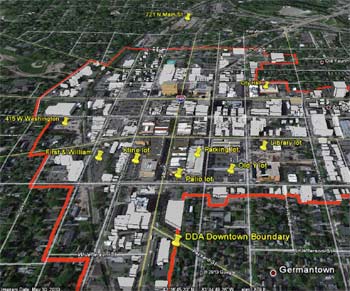
Map from PAC’s subcommittee report showing locations of sites that were examined as possible new downtown parks.
Colin Smith noted that the general recommendations of the subcommittee are a good departure point for activities that PAC will be undertaking in the future. That includes developing recommendations for the budget, he said. A recurring theme is that to make spaces successful, it requires programming – and that requires people and effort. “It doesn’t just happen,” Smith said.
Karen Levin noted that one of the positives for putting a new park or open space on the Library Lot is that potential exists for a connection to Liberty Plaza. Ault pointed out that the Kempf House Museum is also in that area, adjacent to Liberty Plaza.
Bob Galardi said he didn’t think the city has yet realized the full potential of the fee waiver. No one has yet approached the city to put in a month-long art installation, for example. That fee waiver is something in the offing to help the plaza, he said. Smith noted that a musician had reserved the plaza for a performance recently, using the fee waiver.
Stults reported that the environmental commission’s work plan includes a recommendation to work with neighborhoods, as something that’s critical for building more resilient, stable communities. All neighborhoods have parks, so there’s a very interesting connection to be made, she said. Stults plans to make a budget recommendation to fund a park programmer, to make sure that all neighborhood parks are activated in a way that builds community and a sense of place.
Downtown Park Recommendation: Commission Discussion – Amendments
At the suggestion of Christopher Taylor, one change was made to the second recommendation – adding the word “necessary”:
2. New downtown parks and open space should adhere to placemaking principles. Necessary criteria for a successful downtown open space include: high traffic/visibility; flexible programmable space; active use on at least three sides; the ability to provide activities desired by the community; and funding for maintenance and security.
All other changes focused on the final recommendation (8) about the specific Library Lot site. The original recommendation stated:
8. Based on the aforementioned criteria, the Downtown Parks Subcommittee recommends that a park/open space be developed on the Library Lot that takes advantage of the flexibility offered through temporary closures of Library Lane. The size of this space should exceed the proposed allocated open space in the Connecting William Street study. However, the subcommittee is strongly in favor of a mixed-use vision for the Library Lot. Adjacent development, including the accompanying increases in activity, is essential for the future success of additional downtown open space. In order to adequately address issues of safety and security, the Ann Arbor District Library must also be strongly represented in the planning process.
Taylor pressed to include language that acknowledged the need for development on the Library Lot, not just on adjacent sites. He also suggested adding the word “density” to the phrase “accompanying increases in activity” so that it would read “accompanying increases in activity and density.”
Alan Jackson wasn’t sure the word “density” captured what the subcommittee intended. Taylor described the word as a proxy for “more people doing more things” downtown, and he thought it was consistent with what the subcommittee was recommending. However, there was little enthusiasm among commissioners for adding the word, with the sense that it was restrictive because it typically refers to residential development.
Julie Grand said the subcommittee recognized the need for development on that space in order to activate the area. They also didn’t want to ignore the real investment in infrastructure that had been made to support a building on the Library Lot site, she said. “I think those are two very strong reasons to support development on it,” she added.
Bob Galardi didn’t want the recommendations to go forward without including a mention of development. If something isn’t built on that site that faces the open space area, “that is a real problem, at least for me,” he said. The library will draw people past the site, he noted, but a mixed-use development could draw people into the space.
There was some discussion about the size of the open space, with consensus that it should exceed the minimum 5,000 square feet that was recommended in the Connecting William Street report. By way of comparison, Smith reported that Liberty Plaza is nearly 12,000 square feet, while Sculpture Plaza is slightly smaller than 5,000 square feet. Beyond indicating a desire to exceed a minimum amount of space, Smith didn’t think it was necessary to make a specific size recommendation. What really matters is the quality of the design, he said.
Taylor made some suggestions for changes, including a mention of the city’s investment in infrastructure and adding a reference to density. He noted that as an ex officio non-voting member of PAC, he was not in a position to move amendments himself.
After additional back-and-forth about possible wording, commissioners ultimately agreed to several friendly amendments in the eighth recommendation [added text in italics, deletions in strike-through]:
8. Based on the aforementioned criteria, the Downtown Parks Subcommittee recommends that a park/open space be developed on the Library Lot that takes advantage of the flexibility offered through temporary closures of Library Lane. The size of this space should exceed the proposed allocated open space in the Connecting William Street study (5,000 square feet). However, the subcommittee is strongly in favor of a mixed-use vision for the Library Lot that utilizes the city’s investment in development-ready foundation and infrastructure. Adjacent Development of the site and adjacent parcels, including the accompanying increases in activity, is essential for the future success of this site additional downtown open space. In order to adequately address issues of safety and security, the Ann Arbor District Library must also be strongly represented in the planning process.
Outcome: Commissioners unanimously voted to approve the downtown parks subcommittee report and recommendations, as amended. It will be forwarded to the city council for consideration.
Upper Mallets Creek Project
Harry Sheehan – environmental manager with the Washtenaw County office of the water resources commissioner – briefed commissioners about how a broad stormwater management project for Upper Malletts Creek might impact three city parks: Eisenhower, Churchill Downs and Lawton.
After the March 15, 2012 major storm in this region, he said, coupled with chronic flooding problems in this neighborhood, the water resources commissioner’s office – in partnership with the city of Ann Arbor – began to look at potential stormwater management solutions. The area is roughly bounded by I-94, Scio Church Road, and Ann Arbor-Saline Road, on the city’s southwest side.
The Upper Malletts Stormwater Conveyance Study has tentatively identified three major projects to help manage stormwater and control flooding. Two of those projects would affect local parks:
- Building two stormwater detention basins along the north and south ends of Eisenhower and Churchill Downs parks, which are connected. These basins – covering about 2.5 acres – would help manage the stormwater flow from the north along Scio Church Road and from the drainage area west of I-94. (Eisenhower Park is located along I-94, just south of Scio Church Road. Churchill Downs Park is a 1.18-acre neighborhood park located between a residential area and I-94.) Estimated cost: $1.7 million.
- Building a large underground detention basin at the north end of Lawton Park, which is located on Mershon between Delaware and Scio Church. The basin would manage storm flows from both north and south of Scio Church. Existing park amenities – including the baseball/softball diamond – would be replaced and upgraded. Estimated cost: $4.125 million
A third project, which would not involve a city park, entails building a detention basin north of Scio Church Road and east of Seventh Street, on property south of Pioneer High School that’s owned by the Ann Arbor Public Schools. That piece would cost an estimated $1 million and cover about 2.8 acres.
The total project would cost about $10 million, Sheehan said – $2 million for design and $8 million for construction.
In the animated .gif below, which loops continuously, the first frame indicates in black the March 15, 2012 flooded areas. The next three frames show the modeled cumulative effect of adding each of the proposed stormwater detention facilities. That is, the maps show what the flooding would have been like, if the proposed stormwater detention facilities had been in place on March 15, 2012.
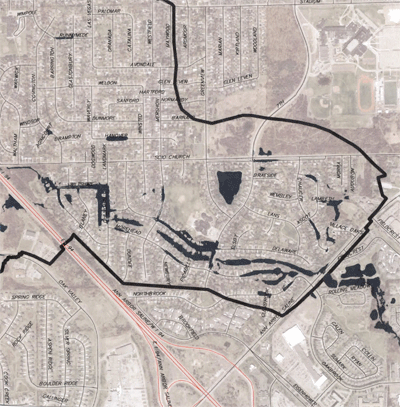
Maps by Spicer Group, the engineering consultant for the upper Mallets Creek stormwater study. Scans and animation by The Chronicle.
The overall project would require city council approval, and it’s not yet clear when a proposal will be brought forward. Colin Smith, the city’s parks and recreation manager, characterized Sheehan’s presentation to PAC as informational, given the potential impact on some parks. When funding is secured, the commission would be briefed on a more detailed plan and would be asked for a recommendation to be forwarded to the city council.
For additional background on stormwater management in this area, as well as related issues, see Chronicle coverage: “Sidewalks: Repair, Build, Shovel.”
Sheehan told commissioners that at public meetings held about the project, residents seemed generally positive. Amy Kuras, the city’s park planner who attended the most recent forum, said she had expected it to be a contentious meeting. People generally were relieved to see someone there from the city’s parks staff, she said, and generally it was a positive meeting.
Upper Mallets Creek Project: Commission Discussion
Missy Stults asked if the project is looking at projections for future storm events, to make sure that the stormwater management system will be able to handle the potential impact of climate change.

Harry Sheehan, environmental manager with the Washtenaw County office of the water resources commissioner.
Harry Sheehan replied that the study entailed looking at several different storm events. In Ann Arbor, the March 2012 storm was extremely localized to this neighborhood. In contrast, earlier this year when there was heavy flooding along the Miller Avenue corridor, he’d driven down the Upper Malletts Creek neighborhood and it was fairly dry. The impact of climate change makes these storm events more intense over a shorter period of time, he noted.
What makes stormwater management more challenging is that the ground is generally saturated in the spring when these types of intense storms typically occur, Sheehan said, and there will likely be more of this due to global warming.
Julie Grand asked for more information about the impact on parks, noting that Lawton Park is located near an elementary school.
Amy Kuras reported that at Lawton Park, the biggest impact will be on the open field, which would be taken out of use during construction. Afterward, it won’t change the use of the park because it’s an underground detention basin.
At Churchill Downs Park, the paths, basketball court and playground would be removed for construction. However, Kuras said, those facilities are ready to be replaced anyway.
In response to a question from Graydon Krapohl, Sheehan explained that if approved, construction likely would happen in the fall of 2014 and finish up in the spring – but no specific year has yet been determined for the project. Kuras added that for the sports field, it would be seeded in the fall after construction, then probably reseeded again in the early spring.
Alan Jackson said he’d gone to one of the meetings, and that it would be helpful to show park commissioners where exactly these projects would occur in the parks. He agreed with the assessment that there seemed to be a lot of positive feedback from residents, though there were concerns about work that would be done in close proximity to Lawton Elementary.
Christopher Taylor asked about the cost, wondering how much of the $10 million is for the parks compared to stormwater, and whether grant funding might be available. Sheehan replied that the project would likely use two of the state funding sources that the county has used in the past for similar projects. The project would pay for any replacement due to disruption in the parks.
Kuras added that if the parks system wanted to do improvements that went beyond the replacement of existing parks facilities, then the city would pay for that.
Mike Anglin said he noticed that the Spicer Group did the analysis for this project. He wondered if Sheehan had records of where the major flooding has occurred, and how close that flooding is to the city’s parks. Sheehan replied that the office of the county’s water resources commissioner has compiled that information, but not necessarily in a readily searchable way.
Sheehan said the outcome of a stormwater calibration study that’s being done now would be useful in graphically representing previous flooding so that future improvements and the impact on reducing that flooding could be shown.
Anglin said he’s hearing that residents don’t want to report when there’s flooding in their homes, because that has financial implications regarding insurance, he noted. He wondered if there was a way of doing some kind of “secret recording” because it seems like the city needs the data. Sheehan told Anglin he’d get a response on that question from the city’s systems planning unit.
Anglin said he’d like to continue to look for possible land acquisition in the city’s watersheds, adding that the city should “buy them, as fast as we can.” The city can’t afford to keep doing projects like this stormwater management work, he said, nor can the city afford the drop in property values that results from people leaving the community because of potential flooding.
Praising Sheehan and others who’ve been working on this issue, Anglin said the city needs to get the word out that they’re working “aggressively” on the problem.
Taylor said he noticed that there doesn’t seem to be work planned for the area east of Seventh Street. He wondered if there are any plans for that neighborhood. Sheehan replied that they looked at that area, but when the analysis was done, doing stormwater detention in that area provided only very limited benefit. The project would require that pipe running underneath Seventh to be replaced, to create a clearer flow path for the water, Sheehan said, but that’s the only thing planned at this point.
Outcome: This was not a voting item.
Upper Mallets Creek Project: Public Commentary
At the end of the meeting, Bill Higgins addressed the commission during public commentary. He said he lived south of Scio Church Road, near Pioneer Woods and Greenview Park. Residents are concerned about the appearance of the woods after the work is done. He said he knows it’s not a city park, but somehow the school system needs to get involved in the design process. Scio Church Road is a “disaster,” he said, and now the city is putting money into it for sanitary sewer, water problems, sidewalks and gutters. [See Chronicle coverage: “Sidewalks: Repair, Build, Shovel.”]
Higgins wondered how many of the commissioners had visited Eisenhower Park, especially on the north side, which fronts Scio Church Road. People have to bypass the park and walk along the road to get to the bridge over I-94 – to get to the Ice Cube and Pittsfield branch library. That park could be enhanced and developed, and it would be good for the city to start looking at that possibility, he said. There could even be a small parking lot put in there, he said. Very little attention has ever been paid to people who live south of Scio Church Road, he noted. Higgins said he personally has “waterfront property” occasionally, so he’s very interested in the proposed impounds. Unless all of the impounds are built, “it won’t work,” he concluded.
Capital Projects Update
Colin Smith, the city’s parks and recreation manager, told commissioners that in the late fall or early winter, staff will typically give an update to PAC about projects that have been worked on during the construction season. On Oct. 15, the presentation was given by park planner Amy Kuras.
Highlights from her report:
- In Esch Park – a roughly 4.5-acre neighborhood park located near Packard Road – asphalt paths were replaced with concrete and a new pathway to the play area was constructed to provide barrier free access. The basketball court was reconfigured and replaced, landscaping was added, and several pieces of playground equipment were replaced.
- The first phase of a major renovation at Gallup Park‘s livery and dock area is finished. The second phase started on Labor Day and will continue until the weather gets bad. It will include entry road improvements and separating the service drive from the pedestrian path. The project is funded in part by a $300,000 state grant.
- Work is underway at the urban plaza next to the Forest Avenue parking structure in the South University area – known as “Transformer” Plaza, because there are several utility transformer boxes located there. As part of the site plan approval process for the Landmark and Zaragon II apartment complexes in that area, developers were asked to make donations to the parks system. That funding is being used to improve the plaza, Kuras said. The project – repaving the plaza with colored, patterned concrete – was done in conjunction with street improvements to Forest Avenue this summer.
- A major donation had been made to the city for landscaping in the parks, so that funding was spent to “spruce up” the entrances to several recreational facilities, Kuras said, including Bryant and Northside community center, the senior center near Burns Park, the ice arena at Buhr Park, the golf courses, and the rain garden at Gallup.
- Roofs were replaced at Mack pool and Veterans ice arena.
- Ballfields were renovated at West Park, Veterans Memorial Park, and Southeast Area Park.
- Work continues on the skatepark in the northwest corner of Veterans Memorial Park. Kuras described the partnership of the city, Washtenaw County parks & recreation, and the Friends of the Ann Arbor Skatepark, as well as funding from the state. Here’s a short video clip provided by the parks staff of workers recently applying “shotcrete” to one of the bowls.
Capital Projects Update: Commission Discussion
Alan Jackson asked whether the solar panels on the roof of the Veterans ice arena were re-used. Amy Kuras said she met with members of the city’s energy commission and energy staff, to try to figure out what to do with the panels. About a third to a half of the panels no longer function. In addition, the previous installation of the panels is believed to have contributed to the roof leakage, she said. So the staff will continue to work on that issue, but at this point the panels are being stored outside of the building.
Colin Smith, the city’s parks and recreation manager, commended Kuras for her work on these projects, as well as other staff, including Jeff Straw, Matt Warba and Nicole Woodward.
Ingrid Ault said she’s been hearing “unbelievably positive” feedback from residents about these improvements, and it’s exciting to see.
Outcome: This was not a voting item.
Communications & Commentary
There were several opportunities for communications from staff or commissioners during the Aug. 20 meeting. Here are some highlights.
Communications & Commentary: Environmental Commission Work Plan
Missy Stults, PAC’s representative on the city’s environmental commission, reported that the commission has developed a work plan with about 10 strategies that are mostly tied to the city’s sustainability framework and climate action plan. [.pdf of environmental commission's work plan] The plan includes work to promote re-useable water bottles and to discourage the use of plastic water bottles. So the idea is to develop an app that would show people where to get public water, including water fountains in city parks. There’s also work to map the city’s vulnerability to climate change, she said, such as flooding.
Stults also said there’s a community visioning process underway to understand what a resilient Ann Arbor would look like. It includes how the city would bounce back from events that impact residents, she noted, but also how the city can “bounce forward” and prepare for the future. This will be about an 18-24 month process. In a related item, she reported that the city council recently approved applying to be designated as one of 100 Resilient Cities by the Rockefeller Foundation.
There are also preliminary discussions about how to handle smoking in the city’s parks, Stults said. It was an issue that one of the city councilmembers who serves on the commission has raised, because it had been raised by constituents. [Two councilmembers – Sabra Briere (Ward 1) and Chuck Warpehoski (Ward 5) serve on the environmental commission.]
The commission is also looking at recommending a resolution to the city council advocating to ban fracking in the city.
Tying in with the work plan item regarding water use, Colin Smith reported said the city is looking to replace several water fountains at parks and recreation facilities with f0untains that indicate how many plastic bottles have been saved by people using the fountain. He noted that the city took the idea from similar fountains used at the University of Michigan.
Mike Anglin, a Ward 5 city councilmember who serves as an ex-officio member of PAC, noted that councilmember Sabra Briere (Ward 1) recently brought forward a resolution to the council regarding the Pall-Gelman 1,4 dioxane plume. He felt the environmental commission should always keep that situation in mind, even though it’s embarrassing to the city. You can’t control the weather, he said, but you can probably control this issue with sustained interest.
Anglin said “we’re about to replace a judge who has been responsible for the administration of this for years. He’s going to resign, and we have the chance to appoint a new judge, who may be assigned to this.” [Anglin seemed to be referring to Donald Shelton, chief judge of the Washtenaw County 22nd circuit court, who oversees a consent judgment between the state and Pall Corp. However, circuit court judges are elected, not appointed – unless they resign mid-term. Because of his age, Shelton will be ineligible for re-election when his term ends next year. The state constitution requires that judicial candidates at the time of election must be younger than 70 years old. However, Shelton has not indicated that he will be resigning before the end of his term.]
No one likes to hear that there’s something bad in the community that people should be paying attention to, Anglin said. But the fact is that a mature society faces these issues, he said. There’s a group that’s hoping to vet the judges who might handle this case, Anglin said. That will have an impact on the judge who will ultimately handle this, he added, “because once they’re in, you can’t vet them. You can’t say anything about cases that they’ll handle. But we have a lot to say now.”
Anglin indicated that it’s important to appoint a judge who’s an environmentalist and who’ll enforce regulations. “What we have to do is get a strong set of marching orders that everybody agrees to, from the governor down,” to look at best practices. He noted that the city of Ann Arbor handles 1,4 dioxane at the former landfill, located at Platt and Ellsworth. The technology to do this is available, he said.
Anglin hoped the Ann Arbor city council would appoint at least three councilmembers to an oversight group, including someone from Wards 1 and 5, which are the wards most affected by the Pall Gelman plume, he said. They could look at what can be done and how to move forward. That’s something the environmental commission can explore, he said.
Communications & Commentary: Dog Park Update
Karen Levin, chair of PAC’s dog park subcommittee, reported that the group has now held two public forums, with a lot of good feedback. The subcommittee will be using that feedback, along with survey responses, to continue evaluating possible sites for a new dog park. [.pdf of 306-page dog park survey results] [.xls file of dog park survey results]
Communications & Commentary: Manager’s Report
Parks and recreation manager Colin Smith noted that on Wednesday, Oct. 23 there will be an appreciation potluck for volunteers of the city’s natural area preservation program. It will be held at Cobblestone Farm at 2781 Packard Road from 6:30-9:30 p.m.
Communications & Commentary: Farewell to Julie Grand
The Oct. 15 meeting was the last one for Julie Grand, PAC’s former chair who is term limited after serving six years. Ingrid Ault, who was elected chair to replace Grand at PAC’s Sept. 17 meeting, called her “an amazing force” for the commission. Ault thanked Grand for her work.
Colin Smith, the city’s parks and recreation manager, noted that Grand’s service on PAC almost exactly parallels his own tenure as manager. He said they’ve worked well and collaboratively on several projects, and have seen many improvements over the years. The parks staff have appreciated working with Grand and the support she’s provided to the city’s parks system, he said.
Grand recalled that people would ask her why she attended so many meetings. It’s actually been a pleasure the entire time, she said. That’s because PAC supports a service that the community is really engaged with, Grand said. The parks staff is phenomenal, and the city is fortunate to have that.
She noted that there’s been a transition on PAC, as she’s watched old members leave and new members arrive. Before the new members were appointed, she’d felt a lot of stress, she reported, and had been a “bug in the mayor’s ear” for about a year, urging him to find good appointments. So she’s relieved now that she sees the commission will be left in such good hands.
She told new commissioners that they were fortunate, because in past years PAC had to focus on budget cuts. Now, from that foundation the commissioners can build on it and work on new policies to improve the existing system, she said, without having to make cuts every year.
Grand thanked commissioners for passing the recommendations on downtown parks, saying “it’s a great way to go out.”
She received a round of applause from staff and commissioners, who after the meeting took Grand out to Arbor Brewing Company for a farewell celebration.
Present: Ingrid Ault, Bob Galardi, Julie Grand, Alan Jackson, Graydon Krapohl, Karen Levin, Missy Stults, Jen Geer and councilmembers Mike Anglin and Christopher Taylor (ex-officio members). Also Colin Smith, city parks and recreation manager.
Absent: Tim Berla.
Next PAC meeting: Tuesday, Nov. 19, 2013 at 4 p.m. in the city hall second-floor council chambers, 301 E. Huron St., Ann Arbor. [Check Chronicle event listing to confirm date]
The Chronicle survives in part through regular voluntary subscriptions to support our coverage of public bodies like the Ann Arbor park advisory commission. If you’re already helping The Chronicle with some financial green, please encourage your friends, neighbors and coworkers to do the same. Click this link for details: Subscribe to The Chronicle.




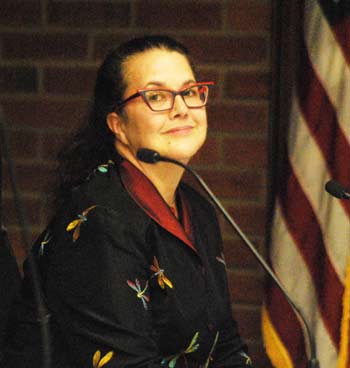
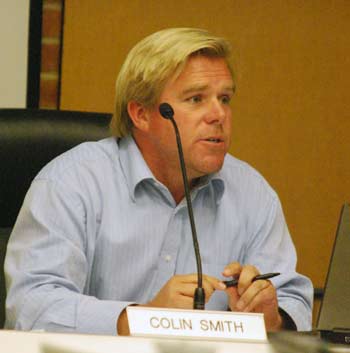

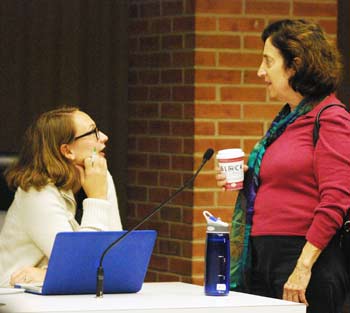
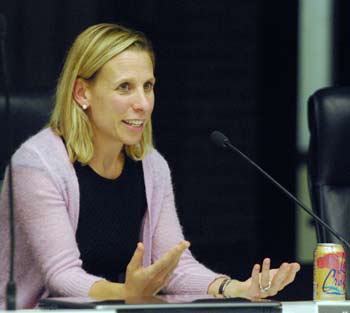
Regarding the Upper Malletts Creek study: I intended to say construction would take the better part of a year at any one of these sites, but did not say 2014. Construction will not happen that quickly. Thanks.
Re. the date of construction on the Upper Malletts Creek project: I’ve corrected the article, and filed a Missed Tick. Thanks for clarifying that point.
@1: It would be great if the construction could include building a non-motorized path connecting South Maple to Northbrook Drive.
[link to .pdf]
page 181. This would be a very valuable non-motorized connection beween the west and south sides of town.